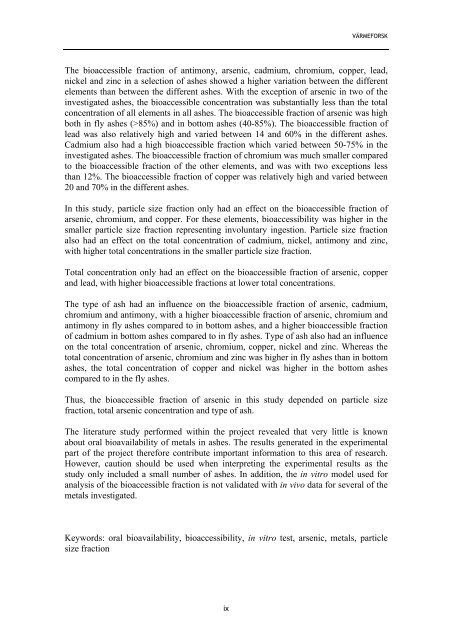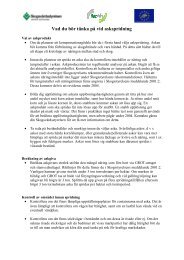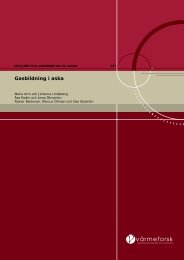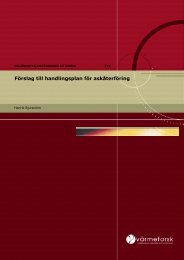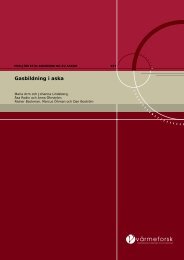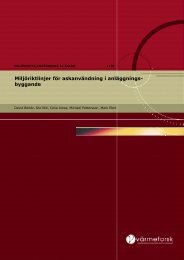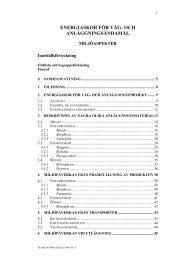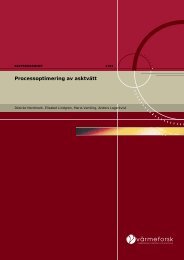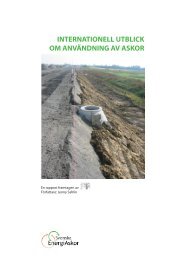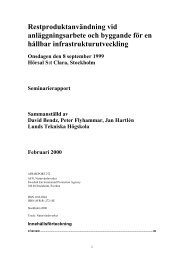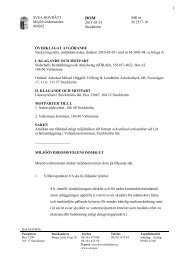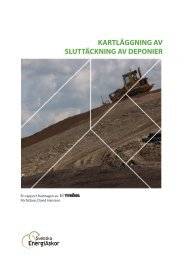Rapport 1056 In vitro.pdf - Svenska EnergiAskor AB
Rapport 1056 In vitro.pdf - Svenska EnergiAskor AB
Rapport 1056 In vitro.pdf - Svenska EnergiAskor AB
You also want an ePaper? Increase the reach of your titles
YUMPU automatically turns print PDFs into web optimized ePapers that Google loves.
VÄRMEFORSK<br />
The bioaccessible fraction of antimony, arsenic, cadmium, chromium, copper, lead,<br />
nickel and zinc in a selection of ashes showed a higher variation between the different<br />
elements than between the different ashes. With the exception of arsenic in two of the<br />
investigated ashes, the bioaccessible concentration was substantially less than the total<br />
concentration of all elements in all ashes. The bioaccessible fraction of arsenic was high<br />
both in fly ashes (>85%) and in bottom ashes (40-85%). The bioaccessible fraction of<br />
lead was also relatively high and varied between 14 and 60% in the different ashes.<br />
Cadmium also had a high bioaccessible fraction which varied between 50-75% in the<br />
investigated ashes. The bioaccessible fraction of chromium was much smaller compared<br />
to the bioaccessible fraction of the other elements, and was with two exceptions less<br />
than 12%. The bioaccessible fraction of copper was relatively high and varied between<br />
20 and 70% in the different ashes.<br />
<strong>In</strong> this study, particle size fraction only had an effect on the bioaccessible fraction of<br />
arsenic, chromium, and copper. For these elements, bioaccessibility was higher in the<br />
smaller particle size fraction representing involuntary ingestion. Particle size fraction<br />
also had an effect on the total concentration of cadmium, nickel, antimony and zinc,<br />
with higher total concentrations in the smaller particle size fraction.<br />
Total concentration only had an effect on the bioaccessible fraction of arsenic, copper<br />
and lead, with higher bioaccessible fractions at lower total concentrations.<br />
The type of ash had an influence on the bioaccessible fraction of arsenic, cadmium,<br />
chromium and antimony, with a higher bioaccessible fraction of arsenic, chromium and<br />
antimony in fly ashes compared to in bottom ashes, and a higher bioaccessible fraction<br />
of cadmium in bottom ashes compared to in fly ashes. Type of ash also had an influence<br />
on the total concentration of arsenic, chromium, copper, nickel and zinc. Whereas the<br />
total concentration of arsenic, chromium and zinc was higher in fly ashes than in bottom<br />
ashes, the total concentration of copper and nickel was higher in the bottom ashes<br />
compared to in the fly ashes.<br />
Thus, the bioaccessible fraction of arsenic in this study depended on particle size<br />
fraction, total arsenic concentration and type of ash.<br />
The literature study performed within the project revealed that very little is known<br />
about oral bioavailability of metals in ashes. The results generated in the experimental<br />
part of the project therefore contribute important information to this area of research.<br />
However, caution should be used when interpreting the experimental results as the<br />
study only included a small number of ashes. <strong>In</strong> addition, the in <strong>vitro</strong> model used for<br />
analysis of the bioaccessible fraction is not validated with in vivo data for several of the<br />
metals investigated.<br />
Keywords: oral bioavailability, bioaccessibility, in <strong>vitro</strong> test, arsenic, metals, particle<br />
size fraction<br />
ix


